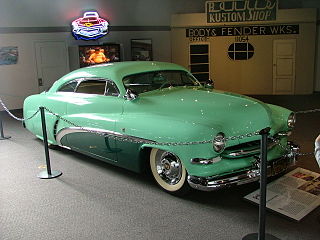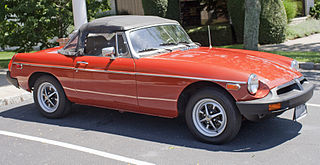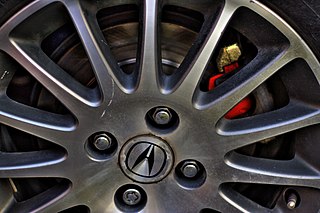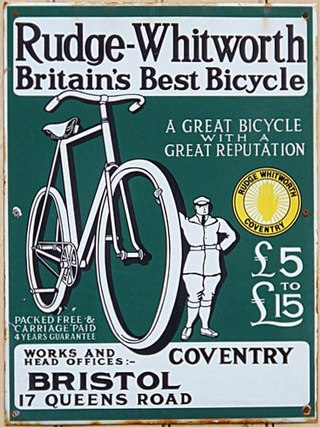
A wheel is a rotating component that is intended to turn on an axle bearing. The wheel is one of the key components of the wheel and axle which is one of the six simple machines. Wheels, in conjunction with axles, allow heavy objects to be moved easily facilitating movement or transportation while supporting a load, or performing labor in machines. Wheels are also used for other purposes, such as a ship's wheel, steering wheel, potter's wheel, and flywheel.

A lowrider or low rider is a customized car with a lowered body that emerged among Mexican American youth in the 1940s. Lowrider also refers to the driver of the car and their participation in lowrider car clubs, which remain a part of Chicano culture and have since expanded internationally. These customized vehicles are also artworks, generally being painted with intricate, colorful designs, unique aesthetic features, and rolling on wire-spoke wheels with whitewall tires.

A hubcap or hub cap is a decorative disk on an automobile wheel that covers at minimum the central portion of the wheel, called the hub. An automobile hubcap is used to cover the wheel hub and the wheel fasteners to reduce the accumulation of dirt and moisture. It also has the function of decorating the car.

A steering wheel is a type of steering control in vehicles.

The term custom wheel refers to the wheels of a vehicle which have either been modified from the vehicle manufacturer's standard or have replaced the manufacturer's standard.

Whitewall tires or white sidewall (WSW) tires are tires having a stripe or entire sidewall of white rubber. These tires were most commonly used from the early 1900s to around the mid 1980s.

A custom car is a passenger vehicle that has been altered to improve its performance, change its aesthetics, or combine both. Some automotive enthusiasts in the United States want to push "styling and performance a step beyond the showroom floor - to truly craft an automobile of one's own." A custom car in British usage, according to Collins English Dictionary, is built to the buyer's own specifications.
A pimpmobile is a large luxury vehicle, usually a 1960s, 1970s or 1980s-model Lincoln, Cadillac, Buick or Chrysler vehicle, that has been customized in a garish, extravagant and kitsch or campy style. The style is largely an American phenomenon.

The rim is the "outer edge of a wheel, holding the tire". It makes up the outer circular design of the wheel on which the inside edge of the tire is mounted on vehicles such as automobiles. For example, on a bicycle wheel the rim is a large hoop attached to the outer ends of the spokes of the wheel that holds the tire and tube. In cross-section, the rim is deep in the center and shallow at the outer edges, thus forming a "U" shape that supports the bead of the tire casing.

Rostyle wheels are a design of automobile wheels of American origin but made under licence by the British firm of Rubery Owen – hence RO-Style – The Rostyle wheel was especially popular during the 1960s and 1970s.

A lug nut or wheel nut is a fastener, specifically a nut, used to secure a wheel on a vehicle. Typically, lug nuts are found on automobiles, trucks (lorries), and other large vehicles using rubber tires.

Wire wheels, wire-spoked wheels, tension-spoked wheels, or "suspension" wheels are wheels whose rims connect to their hubs by wire spokes. Although these wires are considerably stiffer than a similar diameter wire rope, they function mechanically the same as tensioned flexible wires, keeping the rim true while supporting applied loads. The term suspension wheel should not be confused with vehicle suspension.

Rudge Whitworth Cycles was a British bicycle, bicycle saddle, motorcycle and sports car wheel manufacturer that resulted from the merger of two bicycle manufacturers in 1894, Whitworth Cycle Co. of Birmingham, founded by Charles Henry Pugh and his two sons Charles Vernon and John, and Rudge Cycle Co. of Coventry.

Ruote Borrani S.p.A. is an Italian manufacturer of automobile and motorcycle wheels. They are known for supplying Rudge-Whitworth design centerlocking wire wheels to many Italian racing cars, sports cars and luxury cars.
The following outline is provided as an overview of and topical guide to automobiles:

In the automotive industry, alloy wheels are wheels that are made from an alloy of aluminium or magnesium. Alloys are mixtures of a metal and other elements. They generally provide greater strength over pure metals, which are usually much softer and more ductile. Alloys of aluminium or magnesium are typically lighter for the same strength, provide better heat conduction, and often produce improved cosmetic appearance over steel wheels. Although steel, the most common material used in wheel production, is an alloy of iron and carbon, the term "alloy wheel" is usually reserved for wheels made from nonferrous alloys.

Hi-risers are a type of heavily-customized automobile, typically a full-size, body-on-frame, rear-wheel drive American sedan. They are modified by significantly increasing the vehicle's ground clearance, and adding large-diameter wheels with low-profile tires. Depending on the model, year and bodystyle, cars customized in this style can be labeled "donk", "box" or "bubble". Many within the community refer to this style of car as simply a "big rim" or "big wheel" car.

A center cap, or centercap is a decorative disk on an automobile wheel that covers a central portion of the wheel. Early center caps for automobiles were small and primarily served the purpose of keeping dirt away from the spindle nut and wheel bearings of vehicles. Center caps are often found on new cars to hide the lug nuts, and/or the bearing. Center caps are a type of hubcap, the other primary type being wheel covers. Some modern center caps are retained to the wheel using spring clips, while others are retained by the wheel lugs or other threaded fasteners.
Car hydraulics are equipment installed in an automobile that allows for a dynamic adjustment in height of the vehicle. These suspension modifications are often placed in a lowrider, i.e., a vehicle modified to lower its ground clearance below that of its original design. With these modifications, the body of the car can be raised by remote control. The amount and kind of hydraulic pumps being used and the different specifications of the subject vehicle will affect the impact of such systems on the height and orientation of the vehicle. With sufficient pumps, an automobile can jump and hop upwards of six feet off the ground. Enthusiasts hold car jumping contests nationwide, which are judged on how high an automobile is able to bounce.
A centerlock wheel is a type of automobile wheel in which the wheel is fastened to the axle using a single, central nut, instead of the more common ring of 4 or 5 lug nuts or bolts.


















